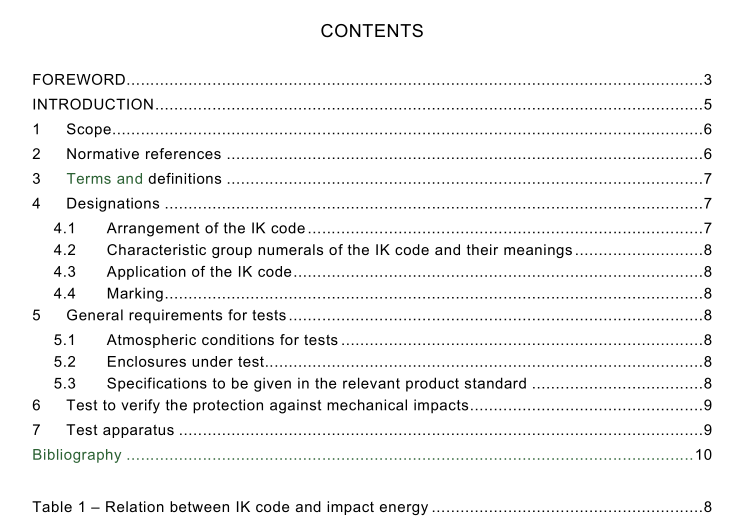IEC 62262 pdf – Degrees of protection provided by enclosures for electrical equipment against external mechanical impacts (IK code)

IEC 62262 pdf – Degrees of protection provided by enclosures for electrical equipment against external mechanical impacts (IK code)
NOTE lK11 can be specified on special enclosures or protection grids for extremely harsh outdoor applications. ltdoes not substitute the sandbag test when specified in the relevant product standard.
4.3Application of the lK code
In general, the degree of protection applies to the complete enclosure. lf parts of theenclosure have differing degrees of protection, the latter shall be indicated separately.
4.4 Marking
In cases where the relevant product committee decides that the marking of the lK-code shallbe required, the marking requirements shall be detailed in the relevant product standard.
Where appropriate, such a standard should also specify the method of marking which is to beused when
one part of an enclosure has a different degree of protection to that of another part of thesame enclosure,
– the mounting position has an influence on the degree of protection.
5 General requirements for tests
5.1 Atmospheric conditions for tests
Unless otherwise specified in the relevant product standard,the test shall be carried outunder the standard atmospheric conditions for tests described in lEC 60068-1:
– temperature range: 15 C to 35°c,
– air pressure:
86 kPa to 106 kPa (860 mbar to 1 060 mbar).
When the altitude at which the test is performed is higher than 2 000 m, the height of fall shallbe adjusted where necessary to result in the specified impact energy.
5.2Enclosures under test
Each enclosure under test shall be in a clean and new condition, complete with all its parts inplace unless otherwise specified in the relevant product standard.
5.3Specifications to be given in the relevant product standardThe relevant product standard shall specify
the definition of “enclosure” as it applies to the particular type of equipment;
the test equipment (e.g. pendulum hammer,spring hammer or vertical hammer,seeclause 7);
the number of samples to be tested;
the conditions for mounting, assembling and positioning the samples,e.g.by the use of anartificial surface (ceiling, floor or wall), in order to simulate intended service conditions asfar as possible;
the pre-conditioning, if any, which is to be used;whether to be tested energised;
whether to be tested with any moving parts in motion;
– the number of impacts and their points of application (see 6.4).
ln the absence of such specifications in the relevant product standard, the conditions of thisstandard shall apply.
6 Test to verify the protection against mechanical impacts
6.1 The test specified in this standard is a type test.
6.2 In order to verify the protection against mechanical impacts,blows shall be applied tothe enclosure to be tested.The devices to be used for this test are described in clause 7.
6.3 During the test the enclosure shall be mounted on a rigid support,according to themanufacturer’s instructions for use. A support is considered to be sufficiently rigid if itsdisplacement is less than or equal to 0,1 mm under the effect of an impact directly appliedand whose energy corresponds to the degree of protection. Alternative mounting and support,suitable for the product, may be specified in the relevant product standard.
6.4The number of impacts shall be five on each exposed face unless otherwise specified inthe relevant product standard. The impacts shall be evenly distributed on the faces of theenclosure(s) under test. ln no case shall more than three impacts be applied in thesurroundings of the same point of the enclosure.The relevant product standard shall specifythe points of application of impacts.
6.5 Test evaluation
The relevant product standard shall specify the criteria upon which the acceptance orrejection of the enclosure is to be based, particularly
admissible damages,
verification criteria relative to the continuity of the safety and reliability of the equipment.In the absence of these criteria, at least the following acceptance criterion shall apply:
– No damage is accepted that impairs the specified lP code.









